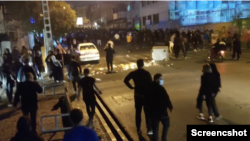Security forces on Thursday shot dead at least three protesters in Mahabad and another two in Baneh, both near Iran's western border with Iraq, said Hengaw, a Norway-based human rights group.
The deadly gunfire came after mourners paying tribute to Ismail Mauludi, a 35-year-old protester killed on Wednesday night, left his funeral and made their way towards the governor's office, it said.
"Death to the dictator," protesters yelled, using a slogan aimed at Iran's supreme leader Ayatollah Ali Khamenei, as the Mahabad governor's office burned, in an online video verified by AFP.
Other verified footage showed clashes near the grave of 16-year-old Nika Shahkarami, outside the western city of Khorramabad, where dozens of people were marking the end of the traditional 40-day mourning period since she was killed by security forces.
"I'll kill, I'll kill, whoever killed my sister," they could be heard chanting, in a video posted on Twitter by the US-based Human Rights Activist News Agency.
Dozens of men were seen hurling projectiles under fire as they drove back security forces in riot gear on a bridge near Shahkarami's tomb.
The latest demonstrations came despite a crackdown that the Oslo-based Iran Human Rights group says has already killed at least 141 protesters, including more than two dozen children.
The protests were held in defiance of warnings from Khamenei and ultra-conservative President Ebrahim Raisi, who appeared to try to link the Amini protests to a mass shooting at a Shiite Muslim shrine in the southern city of Shiraz after Wednesday evening prayers that state media said killed at least 15 worshippers.
But the protests triggered by Amini's death on September 16 show no signs of dwindling, inflamed by public outrage over the crackdown that has claimed the lives of many other young women and girls.
The clerical state has been gripped by six weeks of protests that erupted when Amini, 22, died in custody after her arrest for an alleged breach of Iran's strict dress rules for women based on Islamic sharia law.
Security forces have struggled to contain the women-led protests that have evolved into a broader campaign to end the Islamic republic founded in 1979.
Analysts say the Iranian authorities have sought to quell the protests through various tactics, possibly in a bid to avoid fueling yet more anger among the public.
"I doubt that the security forces have ruled out conducting a larger-scale violent crackdown," said Henry Rome, an Iran specialist at the Washington Institute.
"For now they appear to be trying other techniques -- arrests and intimidation, calibrated internet shutdowns, killing some protesters, and fueling uncertainty and an overall securitized environment," he told AFP.
"They may be making the calculation that more killing would encourage, rather than deter, protesters -- if that judgement shifts, then the situation would likely become even more violent."
Amnesty International called for urgent action to halt the bloodshed.
"Failure to act decisively will only embolden the Iranian authorities to further crackdown against mourners and protesters set to gather in the coming days during commemorations marking 40 days since the first deaths of protesters," it said.
The UN special rapporteur on human rights in Iran on Thursday decried the "brutality" of Iran's regime and called for an international mechanism to investigate scores of deaths.
"In the absence of any domestic channels of accountability... the international community has a responsibility... to take action to address impunity for human rights violations in Iran," said Javaid Rehman.






